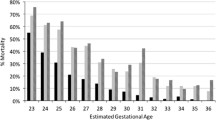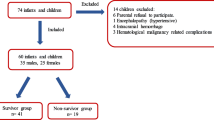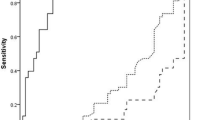Abstract.
Thrombocytopaenia occurs during necrotizing enterocolitis (NEC), and nadir platelet count is associated with extent of disease. In paediatric meningococcal disease, the product of neutrophil and platelet count at admission is prognostically useful. We therefore aimed to determine whether the first full blood count (FBC) after diagnosis of NEC is useful as a score for poor outcome and severity of disease. Between 1987 to 2001, neutrophils (N), platelets (P) and their product (PN) was available in 187 neonates treated for NEC at our institution. Neonates with NEC were grouped according to the extent of disease (no gangrene, focal, multifocal and pan-intestinal). Data were not normally distributed so Mann-Whitney U test or analysis of variance (ANOVA) on logged data were used (p<0.05 was considered significant). Receiver operating characteristics (ROC) curves were used to examine the relationship between specificity and sensitivity. A perfect test would have an ROC curve area of 1. Initial P count and PN product of non-survivors were both significantly lower than in survivors (p<0.0001), whereas N was not different (p<0.08). Low Log10PN was significantly associated with greater extent of disease (ANOVA; no gangrene vs multifocal, p<0.01, vs panintestinal, p<0.0005), suggesting that the initial FBC could be prognostically useful. Area under the ROC survival curve for neutrophils was 0.58, for platelets 0.75 and for PN product 0.71; thus, although no test performed extremely well, initial platelet count and NP product could be useful in evaluating disease severity in neonates with NEC and for further monitoring.


Similar content being viewed by others
References
Hutter JJ Jr, Hathaway WE, Wayne ER (1976) Hematologic abnormalities in severe neonatal necrotizing enterocolitis. J Pediatr 88:1026–1031
Ververidis M, Kiely EM, Spitz L, Drake DP, Eaton S, Pierro A (2001) The clinical significance of thrombocytopenia in neonates with necrotizing enterocolitis. J Pediatr Surg 36:799–803
Ahmed T, Stevens D, Moore AM (1996) Acidosis and neutropenia predict adverse outcome in necrotizing enterocolitis. Pediatr Res 39:1125
Balcom RJ, Clark DA, Rokahr J, Guancial R, Rathbun S (1985) Peritoneal neutrophilic cell response in necrotizing enterocolitis. Am J Dis Child 139:701–704
Peters MJ, Ross-Russell RI, White D, Kerr SJ, Eaton FEM, Keengwe IM, Tasker RC, Wade AM, Klein NJ (2001) Early severe neutropenia and thrombocytopenia identifies the highest risk cases of severe meningococcal disease. Pediatr Crit Care Med 2:225–231
Fasoli L, Turi RA, Spitz L, Kiely EM, Drake D, Pierro A (1999) Necrotizing enterocolitis: extent of disease and surgical treatment. J Pediatr Surg 34:1096–1099
Acknowledgements
This work was supported by a grant from Fondazione Eugenio Litta.
Author information
Authors and Affiliations
Corresponding author
Rights and permissions
About this article
Cite this article
Ragazzi, S., Pierro, A., Peters, M. et al. Early full blood count and severity of disease in neonates with necrotizing enterocolitis. Ped Surgery Int 19, 376–379 (2003). https://doi.org/10.1007/s00383-003-1014-5
Accepted:
Published:
Issue Date:
DOI: https://doi.org/10.1007/s00383-003-1014-5




